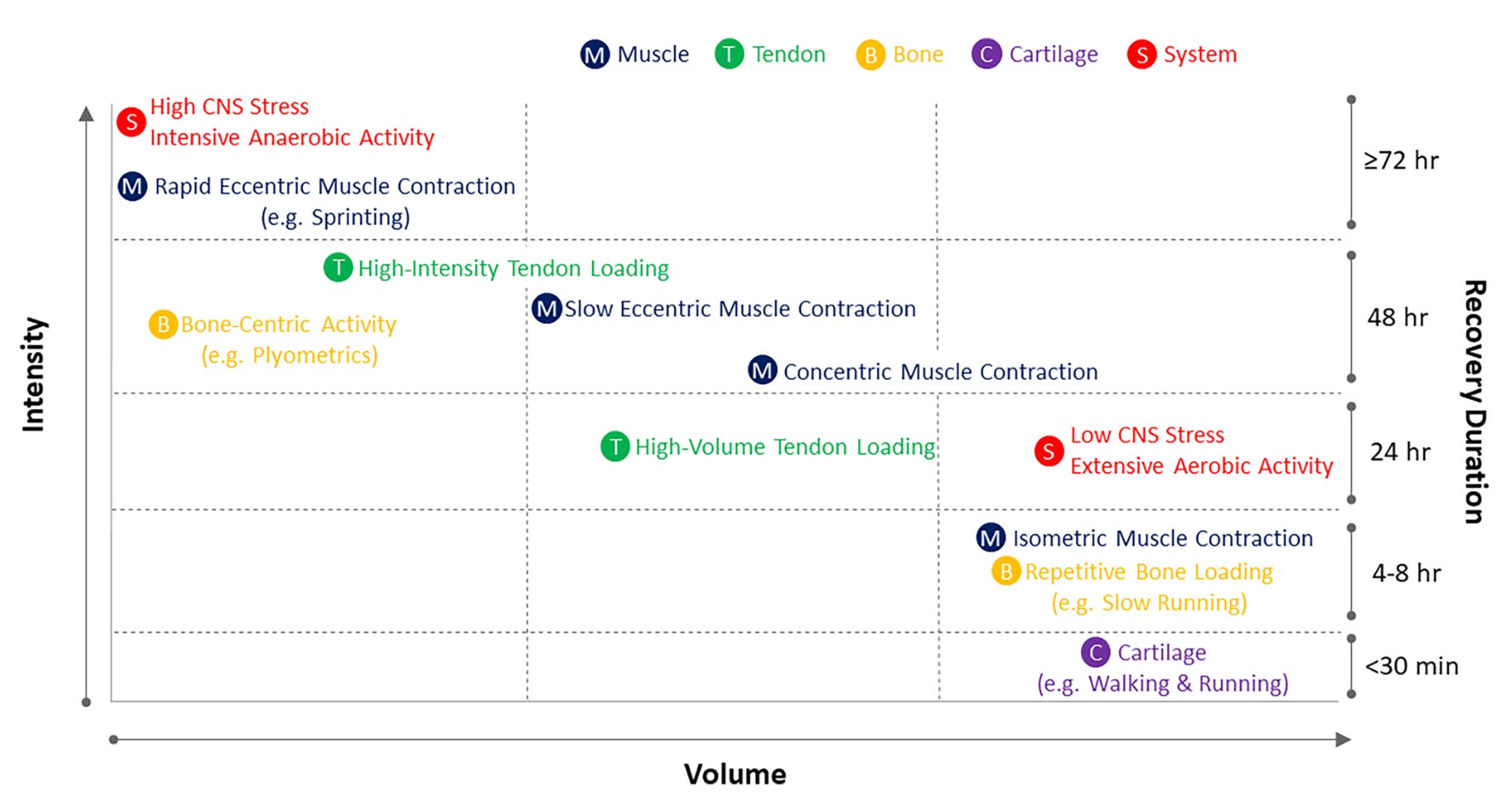The Science of Recovery and Load Management
Train Smart, Recover Stronger: Understanding Your Body’s Response to Load
In the pursuit of peak athletic performance, training intensity, volume, and frequency are critical factors—but understanding how different tissues respond to load is just as important. Research highlights that muscle, tendon, and bone each have unique recovery timelines, meaning a one-size-fits-all approach to training can lead to overuse, fatigue, or even injury.
For example, muscle tissue affected by eccentric training may require up to 72 hours to recover, while tendons that undergo high-stretch, high-intensity loading, such as high speed sprinting, need around 48 hours before they’re ready to perform at their best again. Bone, on the other hand, adapts quickly, with mechanosensitivity dropping after just 20 loading cycles but recovering up to 90% within 8 hours—allowing for additional stimulus if timed correctly.
*NOTE*
Response to exercise stress is influenced by health & training status.
Muscle Adaptations
“6 weeks of sprint training was associated with greater increases in biceps femoris long head fascicle length, sprint performance, and mechanics than isolated hamstring training using the Nordic hamstring exercise (Gabbett & Oetter, 2025).”
Summary: sprinting can build muscle in the hamstrings (6 weeks).
“However, while 20-m sprint, countermovement jump, and isometric mid-thigh pull performance returned to baseline values within 24 h in the subjects who performed isometric exercise, performance was still depressed following 24 h of recovery following heavy resistance training (Gabbett & Oetter, 2025).”
Summary: isometric resistance training will induce less fatigue than eccentric resistance training.
“Others have shown that residual fatigue (i.e., increased muscle damage and delayed-onset muscle soreness and reduced well-being, hamstring force production capacity, and physical performance) persists for > 72 h following team sport competition (Gabbett & Oetter, 2025).”
Summary: team sport competitions (ex. football) takes roughly 3-days to fully recover from.
Tendon Adaptations
“Collagen synthesis peaks ~24 h after exercise. Collagen degradation also occurs post-exercise, but peaks earlier than collagen synthesis (Gabbett & Oetter, 2025).”
Summary: tendons take 24hrs to hit the peak rebuild process.
“Longer intervention periods (≥ 12 weeks) are considered more effective at eliciting tendon adaptations than shorter interventions, although there is evidence that tendons respond positively to mechanical loading within 2 months (Gabbett & Oetter, 2025).”
Summary: significant adaptations to tendons require 2-3 months of training.
“Healthy tendons respond well to consistent (i.e., daily) loading as long as stretch–shorten cycle activity and tendon strain are minimized [67]. Net loss of collagen may occur if less than 24 h recovery is provided between exercise bouts, leaving the tendon vulnerable to injury (Gabbett & Oetter, 2025).”
Summary: strategically load your tendons daily & avoid excessive high intensity loading in back to back training days.
“For example, hyperhydrated and reactive tendons that have undergone high stretch–shorten cycle activity benefit from a 48-h refractory period before receiving a similar training dose (Gabbett & Oetter, 2025).”
Summary: wait 2-days prior to performing the same high intensity training stimulus.
Bone Adaptations
“Multidirectional jumping, landing, and change-of-direction activities are recommended to build a robust skeleton (Gabbett & Oetter, 2025).”
Summary: apply load from different angles and positions to build strong bones.
“Bone cells desensitize to repetitive loading, with 95% of mechanosensitivity lost after as few as 20 loading cycles (Gabbett & Oetter, 2025).”
Summary: bone will be less sensitive to load after 20 consecutive training sessions.
“However, a 4–8 h refractory period restores mechanosensitivity and allows for a second small dose (≤ 60 loading cycles) of bone-centric exercise (e.g., plyometrics), potentially maximizing osteogenesis and adaptive potential in a given timeframe (Gabbett & Oetter, 2025).”
Summary: waiting 4-8hrs between workouts will allow for greater chance of further adaptation.
“Athletes with bone stress injuries are advised to be pain-free during daily activities for 5 consecutive days before commencing return-to-run programs (Gabbett & Oetter, 2025).”
Summary: 5-days of pain free movement following a bone injury signals the athlete may be ready to practice again.
The key to sustainable athletic development is strategic load management. Balancing high-stress anaerobic activities with appropriate recovery and incorporating low-stress aerobic sessions in between can help optimize performance while minimizing the risk of injury. This means structuring workouts with purpose—maximizing gains while respecting the body's natural recovery processes.
At New Wave Performance, we take a science-backed approach to training. Our methodology ensures athletes get the right stimulus at the right time, leading to faster, stronger, and more resilient competitors. Train hard, recover smart, and dominate the game.
References: Gabbett, T. J., & Oetter, E. (2025). From tissue to system: What constitutes an appropriate response to loading? Sports Medicine, 55, 17–35. https://doi.org/10.1007/s40279-024-02126-w

